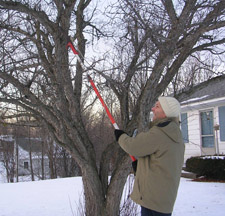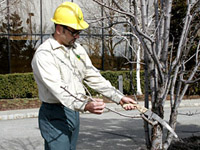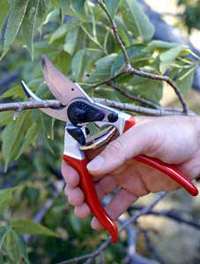
It might be cold outside but late winter is the perfect time to prune fruit trees.
Looking out at the bleak February landscape, it's hard to imagine it will soon be transformed into colorful flowers and foliage. While it's easy this time of year to just daydream about next year's garden, there are some chores to be done. Late winter is the perfect time for one of my favorite garden tasks: pruning fruit trees.
Pruning is perhaps one of the most misunderstood arts in the garden. Most gardeners are nervous about making cuts to their precious trees, and, consequently, they prune only a little, and poorly, or not at all. However, pruning isn't rocket science. You just need to follow some basic principles and get out there and start cutting.
It's impossible to thoroughly cover the techniques for pruning all types of fruit trees in one article, so I'm going to go over some pruning basics and guide you to links that will help you prune specific fruit trees.
Why Prune?
Pruning stimulates new growth, controls the tree size, and improves the size and quality of the fruit. The first goal of pruning is to remove dead or diseased branches and to create a strong branch structure. Trees with strong branch angles and few overlapping or competing limbs have a better chance of a long, productive life.Pruning can control the growth rate of a tree. Heavy pruning stimulates lots of new growth but less fruit production. However, pruning too little can result in a crowded tree with poor branching and yields. Most gardeners have the latter problem. By regulating how much you prune, you can keep the tree in optimum health and production.

A well-pruned apple tree will have strong scaffold branches distributed around a main leader. The open habit helps the sunshine reach the interior of the tree to ripen the apples.
Now that you know some of the benefits of pruning, let's look at the different approaches to pruning different types of fruit trees.
Pruning Systems
There are three basic pruning systems that you'll use to shape your trees.Central Leader System - This system is used on apple, pear, and sweet cherry trees. It creates the classic Christmas tree shape with a strong central branch and many smaller lateral branches growing from it. This system emphasizes removing competing lateral branches and keeping the branch structure balanced.
Modified Leader System - This system is also used on apple and pear trees and some nut trees. This system has a central leader but also three to four other main branches that have equal importance. It's a good system for curtailing the growth of a large tree, making it easier to harvest.
Open Center System - This system is commonly used on peach, nectarine, plum, sour cherry, and apricot trees. The central leader is removed and the center is open with three to four main limbs spaced around the trunk. Many smaller-sized branches emerge from the main limbs to create a rounded shape.

Pruning saws should be used for larger diameter branches. Make clean cuts, leaving a few inches of the branch collar intact so the tree can heal quickly.
Pruning New and Old Trees
In late winter the most severe winter weather is usually over, yet the trees haven't started to actively grow yet so it's easy to see the branch structure. The pruning cuts made in late winter will heal quickly as the trees start growing in spring.When pruning young trees, the goal is to create a strong branch structure and proper angles for future growth. Prune to create three to five branches that have a 45- to 60-degree angle from the main trunk. These branches should ideally be evenly arranged around the trunk and at least 2 to 3 feet off the ground. You can spread the branches when they're young to grow at the right angle. Hang fishing weights with nylon wire on the branches for one growing season, or use wooden "spreaders" to push the branches apart to create the optimal angle.

Use sharp hand pruners that fit snugly in your hand to avoid hand strain while pruning.
For established trees, always remove dead, diseased, broken, and competing branches back to the trunk or a main branch first. For a neglected tree, try not to prune more than 25 percent of the tree in any given year. Too much pruning can cause lots of sucker growth that year. The exception would be a very old tree that needs to be stimulated to put out new growth. The goal is to have large diameter limbs near the bottom of the tree and smaller ones at the top. If you have large diameter limbs near the top of the tree, thin these so they don't compete with the leaders. Don't prune limbs flush to the trunk or main branches. Leave the branch collar (raised area near the trunk or main branch) intact so the branch can quickly heal and protect the wound.
Basic Pruning Cuts
Keep these basic tips in mind:- Use sharp pruning shears for any cuts on branches smaller than 1/2 inch in diameter. Use loppers or a pruning saw for larger diameter wood.
- Cut thin diameter branches 1/4 inch above a bud that is facing in a direction you want the new branch to grow. Make the cut on an angle to shed water and promote faster healing.
- Horizontal branches produce more fruit than vertical ones. Prune vertical branches back to a main stem or trunk.
- In spring and summer, remove suckers arising from the base of the tree and watersprouts arising from branches. Depending on the cuts and type of tree, pruning can stimulate lots of this type of growth, so it's best to remove it quickly so the tree can put more energy into growing fruiting branches.
- Prune moderately every year to keep the tree healthy and fruiting consistently. The tendency of some fruit trees to bear in alternate years can be caused by insufficient pruning. http://www.garden.org/ediblelandscaping/?page=pruning-fruit
No comments:
Post a Comment